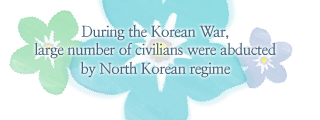Introduction
Korean War Abductees' Family Association (KWAFA hereinafter) was officially established on August 2, 1951. KWAFA publicized nationwide the general meeting through the advertisement on the Donga Daily Newspaper in order to encourage as many people as possible to be participated.
Before the official establishment of the association, surviving families of abductees actively worked on for repatriating the abductees. Wives of civilian abductees autonomously organized a kind of delegation and went up to Pyeongyang and visited Pyeongyang Prison by themselves. Further, they received the reports from surviving families of abductees and produced the lists of abductees swiftly. As a result of such activities, KWAFA was officially founded even after the Chinese' entering and Retreat on January 4, in the Southern end of Korean Peninsula, Busan.
KWAFA had worked for 10 years until 1960 and then had long been interrupted by chaotic political situation. Finally in 2000, the association was re-established with a new name, KWAFU. In spite of remaining families' relentless devotion for repatriating abductees, South Korean government wanted to block all the possibilities of North Korean espionage and kept close watch over the remaining families of North Korean abductees. Such surveillance led to cases of "guilt-by-association" and various forms of discrimination, and discontinuance of KWAFA in the end.
With regard to human rights of the remaining families of abductees, both North and South Korean governments violated their human rights by abandoning the responsibility to rectify the situation ruined by injustice.
The early documents that include petitions, regulations, minutes, quarterly operation report, etc. have been collected and preserved in the National Archives of Korea so as to analyze the situation at that time quite precisely. Among the documents, the most significant ones were contained herein.
1) Certificate of Registration for a Social Organization

(September 25, 1951)
Source
National Archives of Korea
Commentary
This document certifies that the 6.25 Incident Abductee Family Association was registered as a social organization under the Ministry of Public Information on September 14, 1951, after its members had fled to Busan.
2) Registering as an Organization

(January 7, 1954)
Source
National Archives of Korea
Commentary
After being registered as a social organization at the Ministry of Public Information on September 14, 1951, the 6.25 Incident Abductee Family Association held a general meeting in Seoul on August 12, 1953. It was during this meeting that it changed its name to the Korean 6.25 Incident Abductee Family Association. This document is an application for registration that was sent to the Ministry of Public Information.
The attached supplementary documents include the association rules, meeting minutes, resumes of board members, permission documents for advisors, and financial documents. Documents from association advisors, including Kim Hwal Ran, are included here. The fact that the association cooperated with the Ministry of Defense, National Assembly Defense Committee, and Ministry of Public Information shows the considerable status of the organization at the time.
Supplemental Document 2: Minutes of the General Meeting
This meeting was held in an attendance of 22,000 family association members. Presided over by temporary Chairman Kim Jong Gil, the meeting began with an opening address and followed with a report by Jong Bok Hee. After Pak Bong Gil read aloud a message to be sent to the U.N., a discussion on various topics took place.
3) Family Association Regular Report

(December, 1954)
Source
National Archives of Korea
Commentary
After registering as an organization, the first organizational report says that the number of members had reached 17,900 people, an additional 13,300 people from the original 4,600. The drastic rise in members was most likely due to the citing of the family association's list of 17,940 abductees in a report by the Ministry of the Interior's Department of Public Order in 1954.
The family association sent a petition calling for the return of the abductees to the Far East Command at Panmunjeom right before the displaced person exchanges, along with several other petitions to the International Red Cross and other organizations.The organization later created a list of abductees and sent it to the Far East Command and other government organizations.
The repatriation of abducted civilians called for in Clause 59 of the Armistice Agreement did not come about on March 1, 1954. As a result, the family association held a second rally and demonstration calling for the rescue of the abductees on March 11, 1954.
4) In Regards to the Submission of the Fist Regular Report

(March 31, 1959)
Source
National Archives of Korea
Commentary
This regular report shows that the South Korean military representative in the U.N. Central Command's Military Armistice Commission formally requested two copies of the displaced persons list. This request received the signature of Lee Song, a general in the navy. The report records that one copy of the list was provided.
The report that family association members received orders from the government to participate in a national rally opposing the repatriation of Japanese-Koreans to North Korea shows that abductee families were mobilized to participate in rallies not related to the abductee issue.
The report also includes a supplement saying that two telegrams calling for the rescue of wartime abductees and signed by Chairman Yang Mae Ryun were sent to the secretary-general of the International Red Cross and the Red Cross's Korea representative.
5) In Regards to the Submission of the Second Regular Report

(June 30, 1960)
Source
National Archives of Korea
Commentary
This is the last regular report submitted to the Bureau of the Public Information by the first family association. There are no other documents that have been discovered after this one recording the activities of the organization. The first and foremost reason for the halt in the organization's activities is the lack of funds after 10 years of continuous activism.
Moreover, the rapidly changing situation in the late 1950s and early 1960s, including the April 19 Revolution and the establishment of a new government, and the application of guilt-by-association laws toward abductees' families from 1959, were major reasons for the halt in activities.
Results Report
A) The April 19th Revolution
A time when the flag of freedom was covered by the blood of the young
Calls for democracy rang high and low
Oh, the happiness felt when the civilian government gained power on April 26
After the shedding of so much blood!
The Second Republic was met with a combination of euphoria and excitement. Our members visited hospitals to comfort the wounded and give them presents. They comforted the wounded by telling them to get better quickly so they could take the lead in bringing a new future to Korea.
B) Visited the Armistice Agreement Committee in Yongsan on May 15.
C) Sent a letter to the ICRC(International Committee of Red Cross) and asked what happened to it.
D) It has now been 10 years since the communist pirates ruthlessly invaded South Korea. When we think of the difficulties of the last 10 years, the image of our families suffering unspeakable pain in North Korea comes to mind.
It is hard to describe our feelings on this first anniversary of the Korean War since the April 26 revolution. While it is hard to find hope from the fact we have heard nothing from our families for the past 10 years, there is still hope to be found due to the success of the revolution.
We have promised ourselves that even death will not stop us from rescuing our families, and we make new plans and resolutions to do this with the establishment of the new government.
E) We celebrated today by gathering at the house of the chairman and held a temporary members meeting discussing the future of our organization's rescue activities. The hope we have for the April revolution lies in the anticipation it will lead to unification of North and South and to our families.
 (September 25, 1951)
(September 25, 1951) (January 7, 1954)
(January 7, 1954) (December, 1954)
(December, 1954) (March 31, 1959)
(March 31, 1959) (June 30, 1960)
(June 30, 1960)


















 FAX : (82)31-930-6099
FAX : (82)31-930-6099
